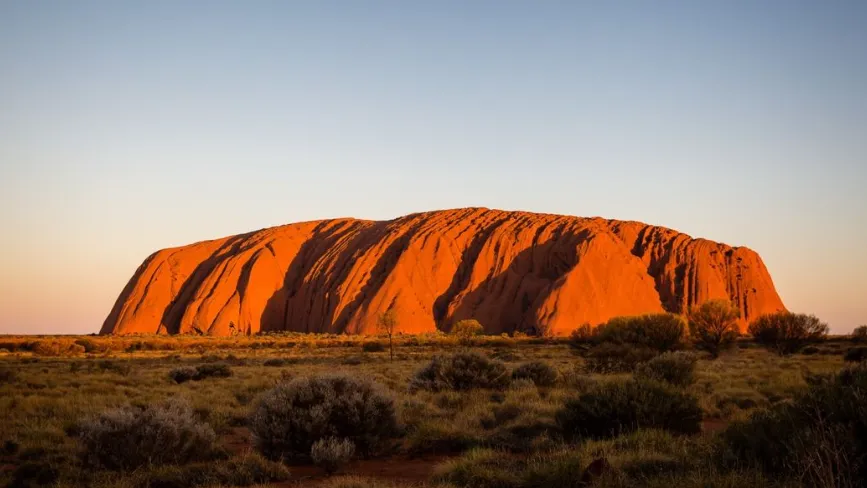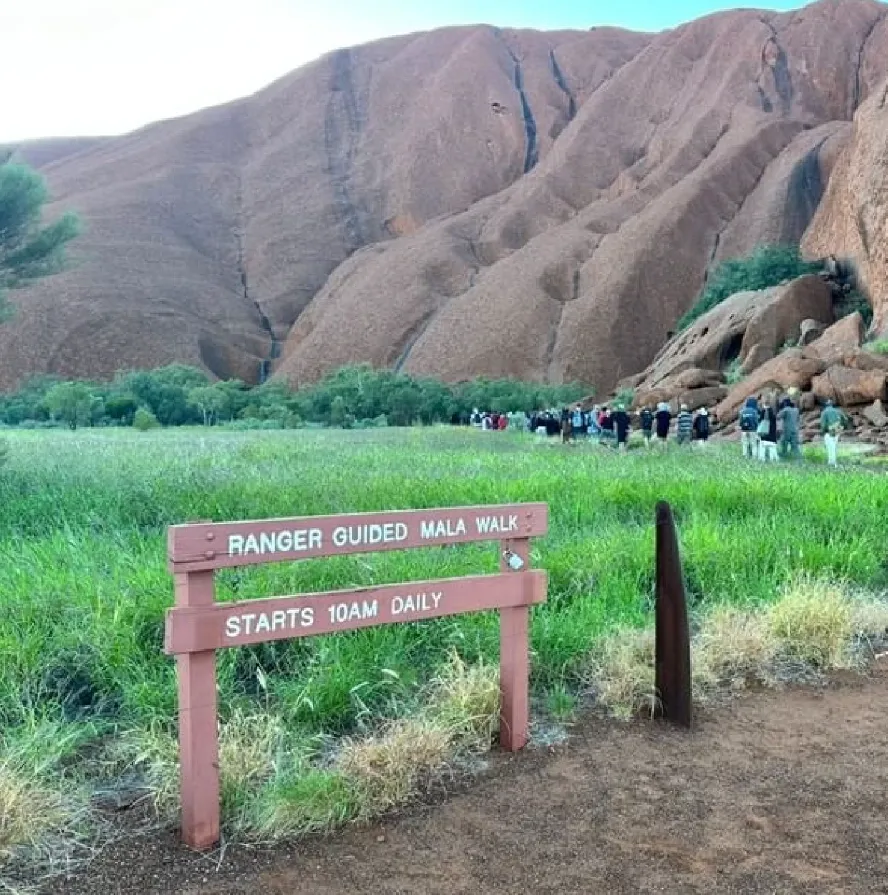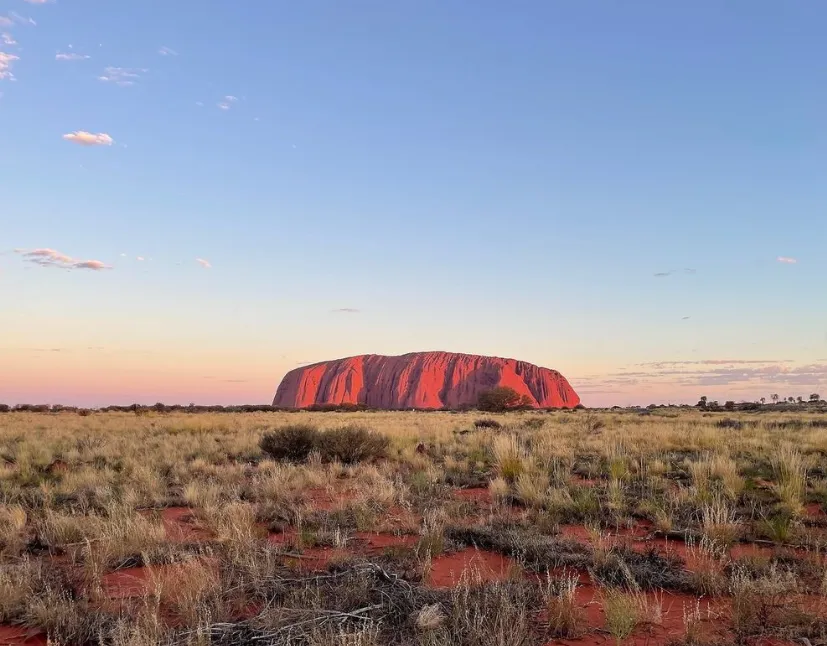Uluru, also known as Ayers Rock, is an iconic sandstone monolith situated in the Northern Territory of Central Australia where it stands out as one of the most prominent Australian landscape features that has immense cultural and spiritual significance to the Aboriginal people specifically its traditional owners, the Aṉangu. For several years Uluru has been subject to both natural processes and human actions that have seen it change significantly. This paper seeks to delve into these changes by identifying significant transformations and showing their impacts.
Physical Changes

Geological and environmental factors have largely influenced physical alterations in Uluru. The actual sand rock consists of arkose sandstone which has weathered over millions of years. Its surface has evolved over time through natural erosion brought about by wind and rain revealing layers of sand and conglomerate rocks. As a result of climate change, temperature differences cause variations in rainfall patterns leading to different rates of erosion on the rock.
The surrounding environment experienced a shift in flora & fauna for example land plants like desert oaks or food sources for animals such as Rufous Hare-wallabies have adjusted themselves to survive under harsh desert conditions while others like camels are introduced species with no native land. Human activities too have had an impact on this landscape with infrastructure development including tourism having affected ecological balance within this area.
Uluru’s geological history starts from when it was formed approximately 550 million years ago when layers of sand together with other softer rocks were deposited within an inland sea at that time. These layers eventually became buried and compacted thereby creating different rock types such as arkose sandstone or conglomerate rocks that are visible today. The formation process involved Petermann mountains which are found westwards of Uluru; they eroded thus depositing sediments that formed Uluru.
This distinctiveness is visible in certain characteristics like steep-sided valleys or erosional features observed on exposed rock faces which have been studied extensively by various geologists and environmental scientists, thereby leading to the accumulation of detailed knowledge about the natural history of Uluru. Its rare flora and fauna species still form part of its natural values that are being preserved.
Cultural and Social Changes

Uluru’s cultural and social landscape has significantly changed. For Aṉangu people, it is a holy place with cultural heritage and creation stories passed down over generations. They consider Uluru as evidence of physical events performed by ancestral spirits during the creation period as well as an important ceremonial pole and cultural location.
The relationship between Indigenous Australians and non-Indigenous people with regard to Uluru has changed over time. Australia initially declared this area crown land but in 1985 it was given back to the original owners who leased it from them under an agreement with Australian government; thus emphasizing cultural values rather than science when administering national parks especially those that involve indigenous communities (Altman 1992). This marked a significant shift in management whereby cultural values were placed at the heart of preservation efforts through recognizing traditional systems knowledge.
Tourism has also transformed Uluru through Ayers Rock Resort among other amenities that have come up there. While this has brought economic benefits, it has also presented challenges such as managing environmental impacts and ensuring that the cultural landscape and sacred sites are respected. Increasing numbers of tourists have led to increased environmental degradation including problems such as human waste disposal or littering which require serious attention (Mattingley & Crouch 2003).
Management plans have been developed in collaboration with Parks Australia and other partners by the Aṉangu to create a balance between tourism and conservation. Protection of cultural sites and minimization of environmental impacts are among measures contained in these plans that ensure Uluru retains its cultural heritage and significance as well as natural values for successive generations.
Policy and Management Changes
Uluru has been well preserved through conservation efforts aimed at maintaining its ecological and cultural worth. The establishment of Uluru-Kata Tjuta National Park formerly Ayers Rock-Mount Olga National Park then Mount Olga National Park is noteworthy in this regard. The board of management together with Parks Australia, which includes descendants from the traditional owners, has adopted policies on sustainable tourism and preservation.
Notably, there was an important policy change towards banning climbing in 2019. For the indigenous Australian tribe called Aṉangu, climbing Uluru had long polarized opinion regarding a sacred place for them. This ban therefore came into effect to uphold cultural values while reducing human effects like damage caused by touching the rock or degradation resulting from littering.
The government of Australia collaborates with Aṉangu plus other stakeholders in managing Uluru-Kata Tjuta National Park. This approach ensures that park management reflects the cultural significance of the land as well as its natural value, besides responding to tourist needs and those of local people. As such, the Board of Management is instrumental in ensuring that sustainability principles and cultural respect inform park policies.
Economic Changes

The development of the tourism industry has had far-reaching economic implications for the region. It is interesting to see how tourism transformed Uluru into one popular destination attracting worldwide visitors who come there to see it themselves These figures have also helped revamp local economies across Australia through job creation within this particular area.
Nevertheless, striking a balance between tourism and conservation remains a difficult task.The government of Australia working alongside Board Of Management is also working hard to come up with management plans that will ensure that economic benefits do not destroy the natural and cultural values of the place. As an example, Ayers Rock Resort has introduced a number of green measures including such as waste recycling programs and low water usage approaches to reduce environmental damage.
Similarly, tourism has necessitated infrastructure development in terms of roads, lodging facilities, and tourist amenities within the vicinity. Some developments in the local community have had positive implications depending on where you stand. Although it created employment opportunities and access to social services, it however put much more strain on cultural sites and environment.
Environmental Impact and Conservation

The impact of climate change could be so severe for Uluru and its surroundings. Changes like warmer temperatures or different patterns of rainfall affect this delicate desert ecosystem greatly. Therefore, both aboriginals’ traditional knowledge along with scientific research should build up adaptation strategies for conserving biodiversity.
Preservation initiatives have focused on protecting both the physical and cultural landscape. Uluru still retains its originality through restoration projects carried out by scientific teams as well as use of technology Advances made in these areas can be attributed to science teamwork and some technological advancements that have been made over time . The site’s universal value as recognized by UNESCO underscores their importance in this regard.
One of the main challenges in conservation is about environmental impacts of tourism. The annual excessive number of visitors to Uluru could result in significant deterioration of the natural habitat and contribute to soil erosion and contamination problems. Parks Australia and Board of Management have taken steps that include restrictions on sensitive areas, waste management improvement as well as encouragement for sustainable tourism.
Future Directions
Looking ahead, continued and future conservation attempts will be vital for Uluru’s preservation. Expected changes in tourism and policy must be carefully managed so as not to damage cultural and natural values. Ongoing collaboration between Indigenous communities and the government will continue to be important in developing sustainable practices.
Uluru’s future will also rest on being able to cope with changing environmental conditions. Thus, climate change may present new issues such as frequent extreme weather patterns or alterations in water resources availability. Therefore, various strategies including habitat restoration, water conservation and development of new technologies for ecological monitoring are being sought by researchers and conservationists to deal with these challenges.
The management of Uluru continues to emphasize cultural heritage significance. Detailed knowledge held by Aṉangu regarding their land and its cultural value would still play a major part in directing any efforts towards conserving it. Combining traditional indigenous wisdom with scientific research can lead to more effective culturally appropriate strategies for managing and preserving Uluru.
Conclusion

The transformation experienced by Uluru over time includes physical, cultural, policy, economic, and environmental changes among others. From geological history till today’s relationships between Indigenous Australians and non-Indigenous ones, this site remains deeply significant too many people around the world who still hold awe about it (White 2004). Continuous preservation is critical if Uluru’s long-standing legacy is preserved; otherwise it shall lose its meaning thus making it impossible for Australians to associate themselves with their rich culture or beautiful nature.
On one hand there is the story of resilience told through Uluru, a story of a landscape as well as the people who have always treasured it. Being a place of outstanding examples of natural beauty and cultural significance, Uluru continues to inspire and captivate people from around the world. The collaboration towards preservation of this site shall ensure that its physical, cultural and spiritual values are maintained for generations (National Australia Day Council 2006).
Embark on an unforgettable journey with Uluru tours as we unveil the stunning changes of this iconic landmark over the years. Learn more today!
FAQ
What is the meaning of Uluru in Australian culture?
Commonly known as Ayres Rock, Uluru is a massive rock and one of the most popular landmarks in Australia. It also contains exceptional cultural and spiritual values for the Aboriginal people, especially traditional owners called Anangu. This rock formation is an important sacred site that has a rich heritage with artifacts like rock art and dream-time stories handed down from generation to generation.
What efforts have been made to preserve Uluru and its surroundings?
The establishment of Uluru-Kata Tjuta National Park initially referred to as Ayers Rock-Mount Olga National Park became significant in keeping off any disturbance within the area such as human interference that can result in loss of both natural features and cultural sites. Management plans prepared by Parks Australia together with Board Management as well as traditional owners are aimed at balancing tourism against conservation. In this respect,it includes reserve areas from tourists, encouraging sustainable tourism practices,and guidelines for reducing human waste products plus habitat destruction.
How has tourism impacted Uluru and its local community?
The impact of tourism on Uluru and its surrounding communities has been enormous. Such projects such as Ayers Rock Resort have generated employment opportunities for indigenous people and supported local enterprises in the area. Nonetheless, there have been problems associated with tourist activities such as pollution which affects the natural environment and derogation from cultural values.
What other noteworthy geological features are located near Uluru?
The district harbors various striking geological features or gigantic rock formations it includes Uluru. Kata Tjuta is a conglomeration of huge rock formations situated toward the west side of Uluru. Kings Canyon however lying northeastward is another remarkable landmark characterized by precipitous cliffs coupled with diverse ecosystems. These formations along Uluru contribute to Central Australia’s peculiar geo-cultural landscape; thus attracting tourists as well as forming subject matters for some research papers like those released by Australian Geographic magazine.”
In the Uluru management, what is the role of the traditional owners?
The traditional landowners, the Anangu people, are critically involved in managing Uluru. They participate actively in decision-making processes including through the Board of Management for Uluru-Kata Tjuta National Park. Their insights into the land and its natural resources as well as cultural values make it possible to develop sustainable practices that protect both the physical and cultural landscapes of Uluru.
